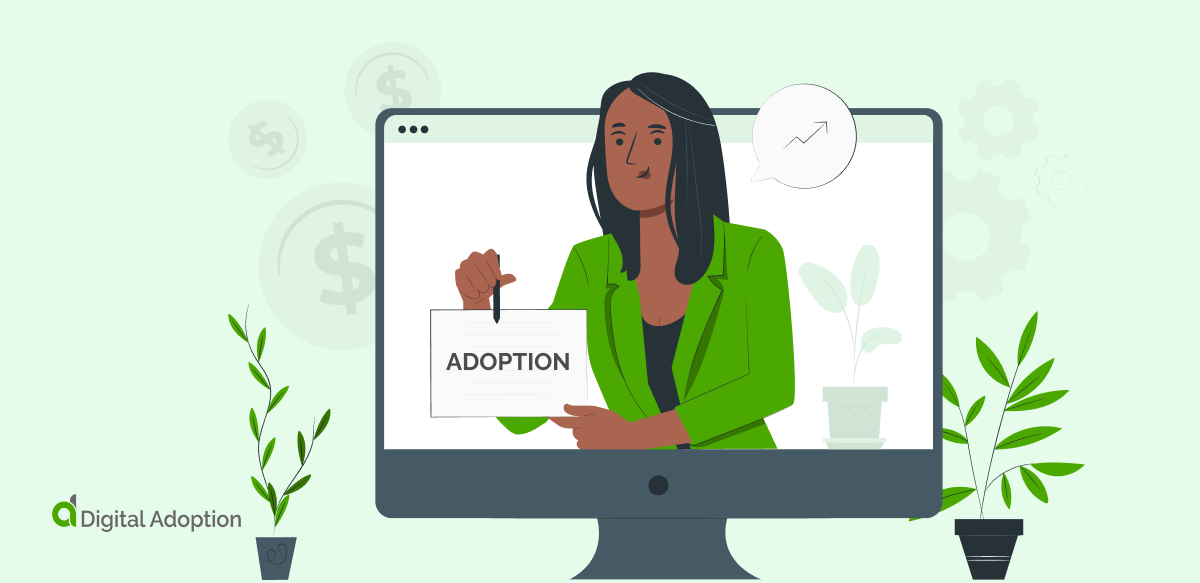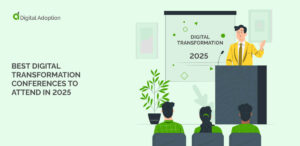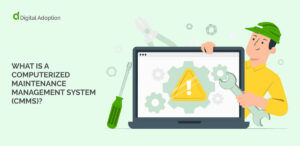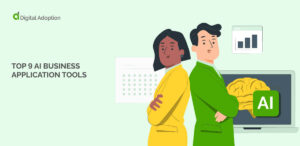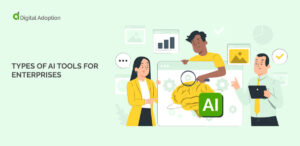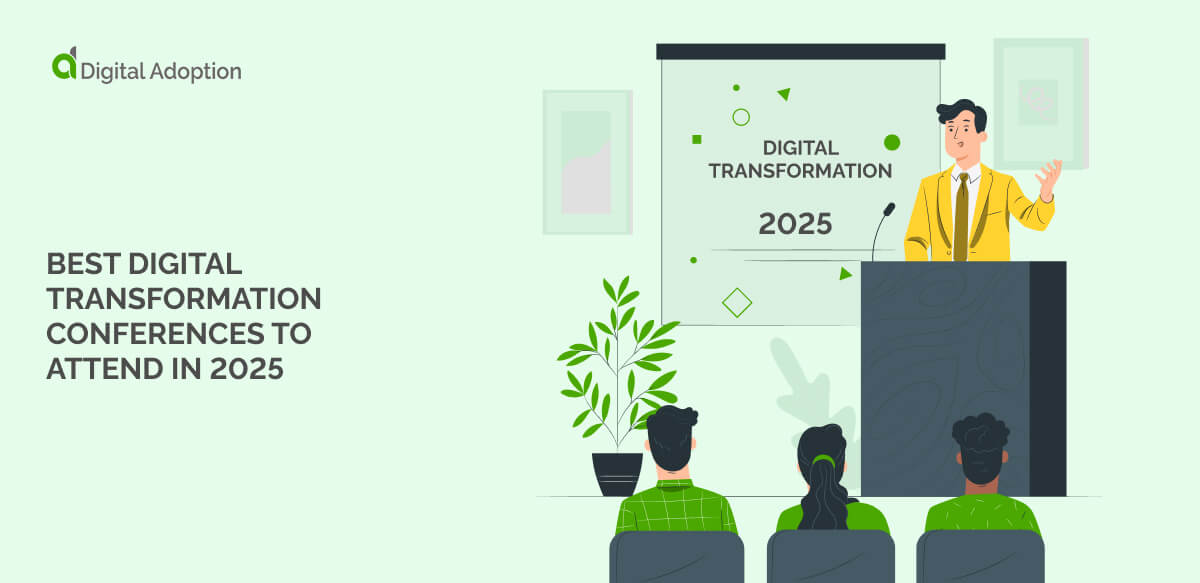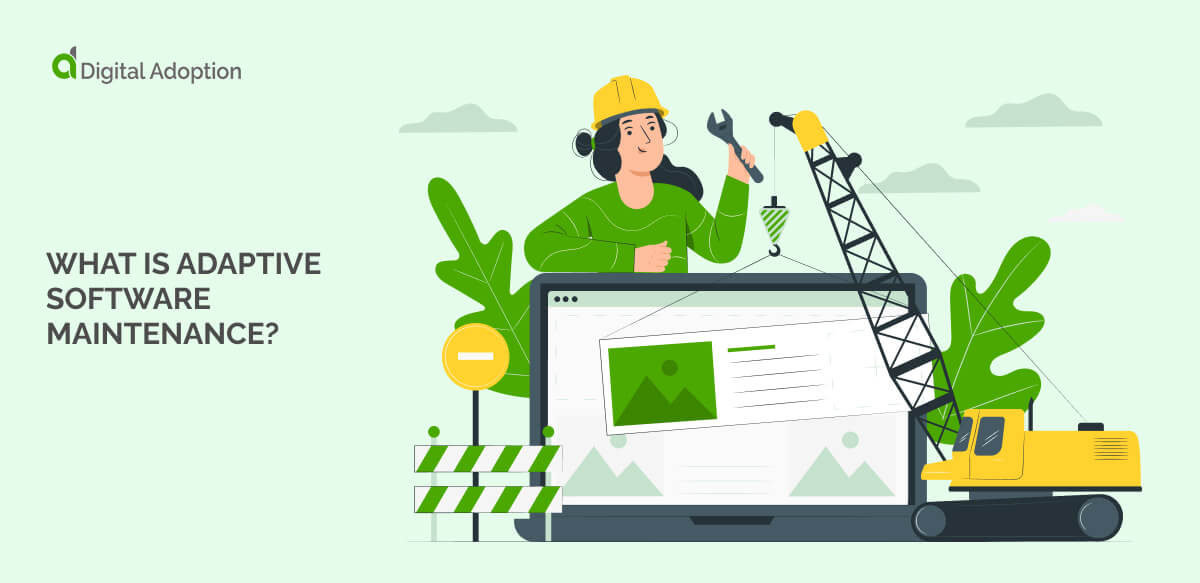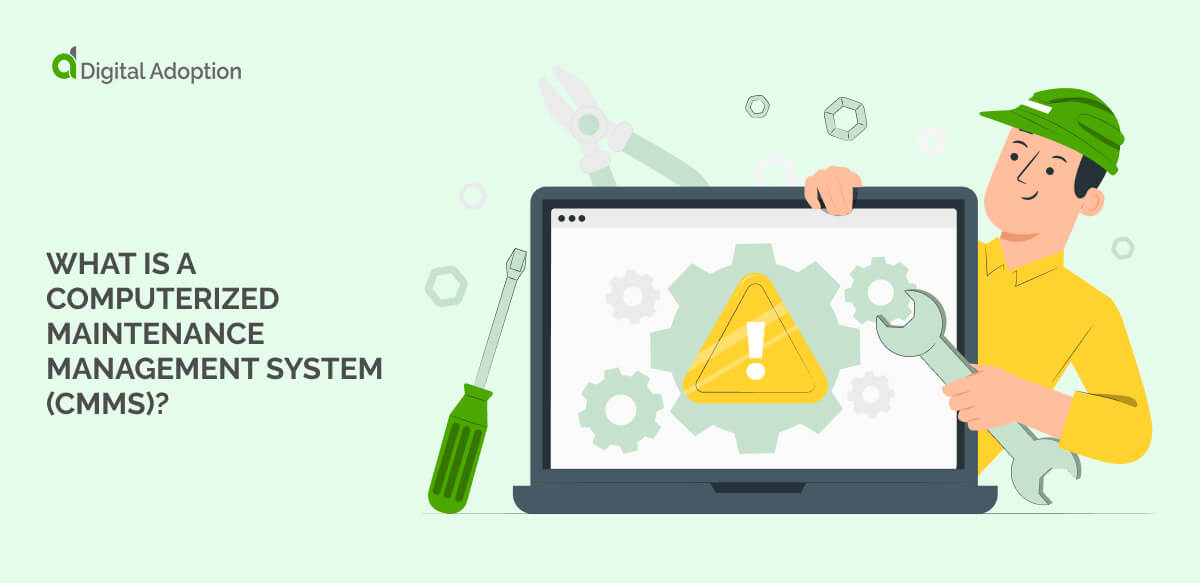Digital adoption can improve any organization. But for companies that specialize in digital solutions or digital technologies, adoption is crucial.
We can probably all agree that user experience is crucial for establishing the value of your products or services. Not only that, but the user experience is critical when it comes to the productivity of your employees — and, therefore, your business.
They say that a business is only as good as its people. Well, people are only as influential as the tools they’re using. And in today’s world, the majority of these tools are digital.
Since technology is constantly evolving, good adoption of digital tools by your business is essential. This goes to the heart of the business adoption meaning. All it takes is a strategic, user-focused approach, and Digital Adoption Platforms (DAP) can be a lifesaver for rapid business adoption of digital.
Without a comprehensive digital adoption solution, a company can’t utilize the full potential of new technology. We’ll be breaking down the benefits of digital adoption and why it’s the most important business process for the growth of digital companies.
Consider this your comprehensive guide to complete digital adoption.
- What is Digital Adoption in Business?
- Business Adoption Definition
- What is the Difference Between Digital Adoption and Digital Transformation?
- Why Adoption Matters in Digital Business
- How to Manage and Improve A Digital Adoption Strategy
- The Ultimate 9-Steps Digital Business Adoption Process
- Support Adoption with a Digital Adoption Platform (DAP)
- How Digital Adoption Platforms Enhance Business Adoption
- How does Digital Transformation Affect an Organization?
- Why is Digital Transformation So Important?
- The Future Of Work
What is Digital Adoption in Business?
You may have heard the term ‘adoption’ thrown around the business world. But what does it mean? Adoption is the process of engaging employees or customers in a new way of doing things.
Digital adoption refers to training and supporting existing employees to adopt digital tools. There are many variables to digital adoption.
Business Adoption Definition
When we talk about business adoption in today’s digital workplace, we’re mainly talking about digital adoption. In that sense, the most helpful business adoption meaning is:
Achieving a state whereby anyone using digital tools for the business is using them “as intended” and to their maximum capability.
Common digital adoption processes
- Technology adoption. The adoption and implementation of new software, hardware, or other technology. Software adoption takes place across all levels of a business and is best.
- Digital adoption. Adopting new digital technology and using it to its fullest extent, maximizing software ROI and user productivity.
- Process adoption. Adopting and integrating new business practices and processes.
- Adoption of new business models. Changing business models, revenue models, strategic frameworks, and so forth.
Every business transformation project involves digital adoption challenges. It’s important to note that not all digital adoption processes succeed. Many adoption processes fail.
Managing, controlling, and optimizing adoption processes can dramatically impact a project’s outcome.
What is the Difference Between Digital Adoption and Digital Transformation?
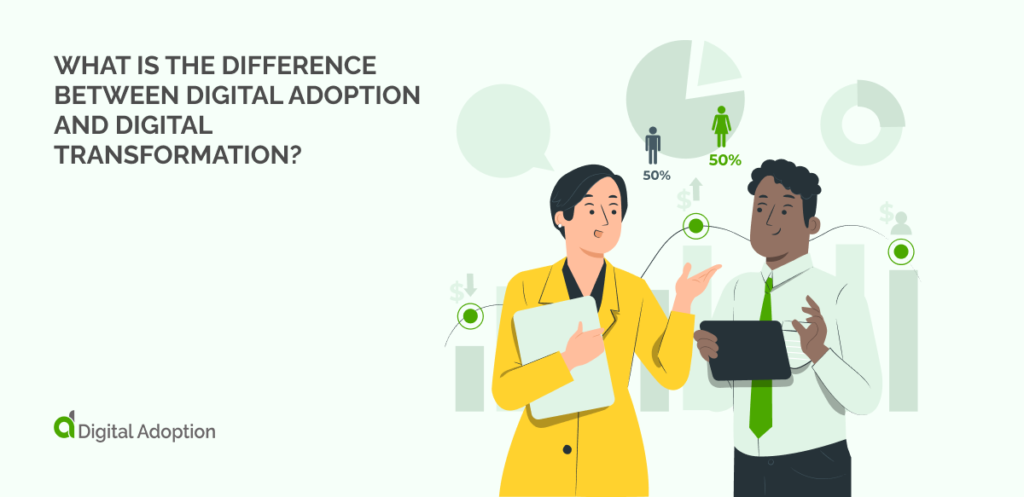
Both processes are directly linked, but it’s essential to understand the difference between each term.
Digital transformation (DX) is using digital technology to improve organizational processes. A successful transformation strategy enhances company processes, increases productivity, and provides better products to customers. Digital adoption is an essential part of this process.
Organizations believe that more technology leads to more efficiency. But they fail to get the most out of digital assets. For example, an organization that wants to automate internal processes like inventory management or recruitment. Suitable software applications can increase efficiency, but only if employees understand how to use them.
Digital adoption (DA) is how a company engages employees in the transformation process. It involves training employees on software. Executives should prioritize adoption if they want to maximize value from software investments.
Digital adoption is about creating a digital-friendly company. A successful adoption strategy changes attitudes to technology.
Why Adoption Matters in Digital Business
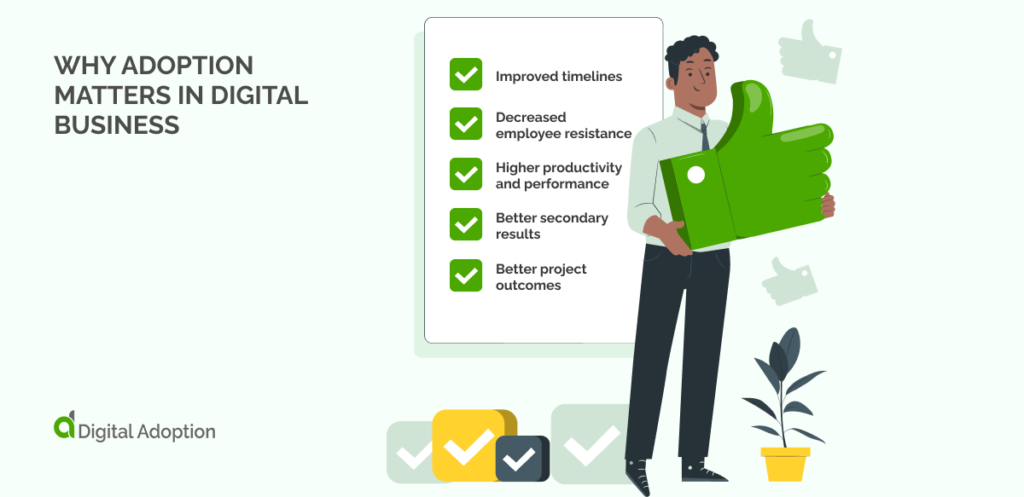
Why is digital adoption important? When executives make a transformation investment, they want to maximize the impact of new digital technologies. That’s where digital adoption comes in.
Many companies rely on digital tools. Any business can improve its digital processes, boost productivity and workflow, and achieve positive returns on investment through new technology. But successful digital adoption requires company-wide engagement from management to workers.
When a company streamlines the transition to new technologies, it achieves digital adoption. This means supporting employees and customers to engage with new digital processes that may be unfamiliar to them.
Benefits of digital adoption:
Lower overhead – New technology leads to more efficient business processes, reducing project costs.
Improved timelines – Efficient adoption management helps speed up project completion.
Decreased employee resistance – Employees often resist change. Influential management leaders drive digital adoption by preventing or overcoming that resistance.
Higher productivity and performance – With proper management, those involved with a project will perform better and achieve more.
Better secondary results – Effective adoption management can produce tertiary benefits above and beyond the primary goal.
Better project outcomes – Finally, better project management often means better project results.
The cost-conscious business pays to understand how to manage these adoption practices. Many business executives view technology investments as risky. This is due to a lack of trust in their organization’s business strategy.
Understanding how to improve your digital adoption process is crucial to obtaining executive buy-in, but it’s only part of the solution.
How to Manage and Improve A Digital Adoption Strategy
Whether you’re integrating a new SaaS platform or a new workflow process, you must have a solid digital adoption plan. There are many proven strategies that business leaders use to get employees on board.
Typical Strategies to Increase Digital Adoption
- A change management strategy. Organizational change is difficult and complex, so every adoption process should have systems for effecting change. Change management involves effective user onboarding, continuous training, and support.
- A digital transformation strategy. The road toward becoming a fully digital business requires a well-thought-out strategy. Every business should have a unique digital adoption strategy to achieve its goals.
- A digital adoption strategy. Achieving successful adoption maximizes user engagement, boosts productivity, and enhances internal processes. All the benefits of digital adoption will also funnel through the company to the customer experience.
The Ultimate 9-Steps Digital Business Adoption Process
Step 1: Purpose Diagnostic
Before starting to plan, you need to understand which part of your business requires tech updates. At this stage, your job is to study every nook and cranny of your organization to identify work processes that need improvement.
Consider individuals in areas of need that can help coordinate the digital business adoption process there. This way you can create a pool of people who will help you execute the upcoming changes.
Step 2: Adoption Roadmap
The second step to take is to create a digital transformation roadmap.
Just like every other change in your company, the digital business adoption requires careful and wise preparation. Now that you already have a vision of which parts of your enterprise require a digital upgrade, it is time to summon your executives and begin planning.
It’s important to have a competent IT specialist consulting in planning. His crucial role should stem from the understanding of integration capabilities of technologies you already use and possibilities to synchronize them with new digital accelerators.
In case you don’t have a fitting specialist on staff, consider hiring a consultant. This action should be marked as a separate step in your roadmap because the specialist will need time to get a grip on how your business operates.
Step 3: Strategic Narrative
Such big changes will eventually change the corporate culture of your enterprise. Therefore, you will have to be ready to communicate the new philosophy to your colleagues, partners, and customers.
It is essential to communicate your strategy, first of all, to your employees. As the company’s building blocks, they will be the first ones to adapt to these changes.
Digital business strategies can have a significant impact on workflow. Your workforce will have to learn how to handle new tools and technologies. To boost this process, help them understand the purpose of the change and the benefits for your employees.
As for your customers and partners, you’ll have to make them aware that these adjustments are a part of your growth as a mindful, modern company.
Step 4: Purposeful Experience
Don’t get too upset if you face resistance to change. This is very likely to happen with your employees if they don’t understand the purpose of the change.
To overcome this issue you will need to acknowledge and highlight even passing results. Be sure, however, that these demonstrations focus on the positivity of small achievements and not on the seemingly infinite process of change.
Step 5: Impact Lab
Just like your employees, your loyal customers might be reluctant to accept the changes. Much of this resistance stems from a failure to understand and adopt. Your company will need to highlight the positive impact via demos or presentations in order to inspire your customers to embrace the change.
Step 6: Leader Onboarding
New digital solutions require new skills. Therefore, you might consider a change of department or unit leadership. From now on, you will need a digitally-forward person in charge of ensuring the productivity of the new system.
Even if you are satisfied with the person you have in the managing post right now, you will have to make sure that they reach the highest level of competence within the new digital business strategy.
Step 7: Behavior & Practices Scoreboard
Feedback is one of the most effective ways to measure the success of any transformative event at your enterprise.
Throughout the digital business adoption process, you will have to develop a framework for measuring adoption response and to highlight successful and failed practices.
Here you might also consider Digital Adoption Platforms (DAP) as a solution. As a software layer that utilises AI-based data processing, this platform will not only help to train your employees and clients but will also collect precious information about customer behaviour and frequent problems.
This data can act as a goldmine of feedback.
Step 8: Best Practice Communities
Stories of success are inspirational. Highlighting the positive practices and spreading the success stories of your employees within different departments will boost morale and reinvigorate the momentum for change.
It could be a good idea to create a kind of forum where employees have the chance to share their experiences of overcoming common issues and help others out when needed.
Step 9: Recognition
Don’t forget to recognize success when it happens. With complex adoption processes, every small victory counts.
Have your employees adopted a new feature in the CRM? That’s a great start and an inspiration for everyone. These cases will help you measure your progress in a clear way and allow your team to understand common goals and values better.
The Best Tools for Improving Your Strategy
- Digital adoption platforms (DAPS). Digital adoption platforms are designed to improve digital adoption processes, such as onboarding and training. Through contextual learning and AI-driven user analytics, DAPS personalizes training experiences and takes them to the next level. This allows employees to learn new tools in an environment that suits them.
- Project management platforms. Project management tools are another must-have for any project. Many organizations utilize project management platforms to improve team communications, collaboration efforts, and more.
- Experience management platforms. Experience management platforms are designed to understand, manage, and improve human experiences. These come under different names, such as user experience platforms, employee experience platforms, or customer experience platforms.
- Learning management platforms. A learning management platform, or system, is a content management system designed for enterprise education. Systems such as these work in-house, allowing trainers to create course content, communicate with students, track student progress, and more.
Support Adoption with a Digital Adoption Platform (DAP)
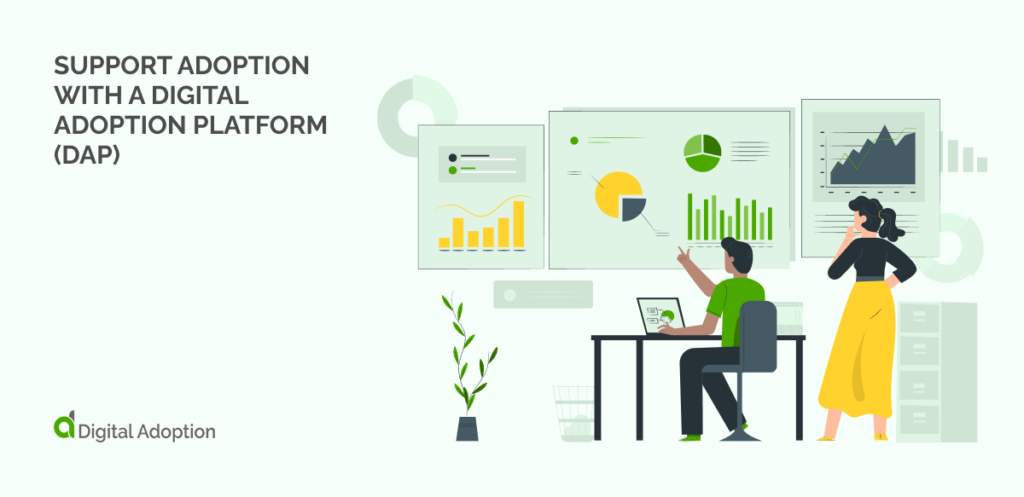
Many businesses fail to implement new software applications because they don’t utilize available tools. There is a myriad of tools and platforms that can accelerate and improve adoption efforts. For example, analytics tools, HR tools, automation tools, and modern IT infrastructures.
Let’s take the digital adoption platforms, for example. A digital adoption platform is one of the most valuable tools for undertaking a transformation initiative. It helps users achieve digital adoption by providing an alternative to traditional training.
A digital adoption platform (DAP) is software that integrates with enterprise applications to help users learn the new system. DAPs guide users through key tasks and monitor their performance. They can provide continuous feedback to management to make necessary adjustments to the training process based on the needs of employees.
Companies embrace digital adoption platforms to increase employee performance. As we know, one of the biggest challenges of digital adoption is employee resistance to change.
A digital adoption platform increases retention through smart onboarding and monitoring. DAPs tailor training materials to individual needs, creating a personalized experience. This enables employees to learn how to use digital tools at their own pace.
Digital adoption solutions are incomplete without a clear strategy and a framework for support and employee satisfaction.
How Digital Adoption Platforms Enhance Business Adoption
The Digital Adoption Platform is an AI-based software layer that provides users with a better experience using any digital tool.
Simply put, it’s software that guides and teaches people how to use digital accelerators in the best way possible. Four distinct features of DAPs make them perfect for boosting business adoption of digital.
1. Onboarding guidance
We can’t cover business adoption meaning without mentioning guidance. Training is 100% critical to good business adoption of digital tools.
The DAP can provide every single user with instant guidance. Like GPS, it will show a step-by-step path of interaction with the digital tool to which it’s applied.
Your business users must get the basics as precise and fast as possible, especially from the start. This guidance plays a significant role during the habit-forming period of using a digital accelerator.
The quicker your business users learn how to get the most out of their digital tools, the better.
2. Consistent mentorship
The DAP provides mentorship to each user during their entire process of interaction.
Digital Adoption Platforms operate based on data collection and machine learning. That means every interaction with that digital tool happens with constant supervision from the adoption platform. Therefore, it can analyze a user’s behavior and select the best approach for advising them.
In addition, the DAP helps collect valuable feedback about users. DAPs can process interactions to evaluate the business adoption process. Besides, they can track behavior or engagement routines that lead to flaws or mistakes in the workflow.
Eventually, you can use this data to fine-tune products and processes.
3. Automatic assistance
The DAP helps your business to stay on top of things because AI has a much faster reaction time than humans. The DAP mimics and adapts to your user’s behavior.
In other words, if a DAP sees that a user understands what they are doing, it won’t bother them with unnecessary information.
Digital Adoption Platforms can also keep their eye sharp in case a user is about to get in trouble or make a reckless mistake. This varying engagement allows for more comfortable adoption of digital tools across the business.
4. Boosting productivity
Without a doubt, the DAP boosts user productivity. You can think of how we usually interact with digital tools such as roaming or meandering. We don’t necessarily take the most efficient route to get something done.
This is particularly true if the tool has a complex UI or if the digital work environment is fast-paced. Often, a user will have trouble selecting the right option from an array of buttons or make unnecessary actions.
Digital Adoption Platforms help resolve this issue by providing tips and guides for any type of workflow. They’re instrumental in fighting the steep learning curve and breaking the bad habits that come with poor adoption.
As a result, the user will be less frustrated by the confusing features of their digital tool, and their productivity will get a boost through improved user experience.
How does Digital Transformation Affect an Organization?
Before taking on a digital adoption strategy, you should know which areas of your business to transform.
Processes
New technology adds efficiency to key activities and functions within a business. You can improve daily marketing, customer service, and human resources operations. Digitalization targets these areas to make it easier for staff to operate.
Increased efficiency then affects the customer experience. Automating customer-facing processes creates a seamless customer experience.
Business Models
Digital adoption opens the door to new business models. New software can create more profitable methods of work. For example, assets such as data become more valuable. Technology allows a company to collect more accurate insights on customer behavior to offer a better service.
Business Ecosystems
Digitalization encourages collaboration between companies with similar models. Expanding your network is a great way to stay ahead of the competition and keep up with the demands of stakeholders.
Organizational Culture
Through digitalization, organizations develop a digital-first culture. But what does a digital culture look like? It means that employees and executives are always prepared to adapt to the future of new technology. Adaptability is crucial to successful adoption as it means companies can respond to evolving demands quickly.
Why is Digital Transformation So Important?
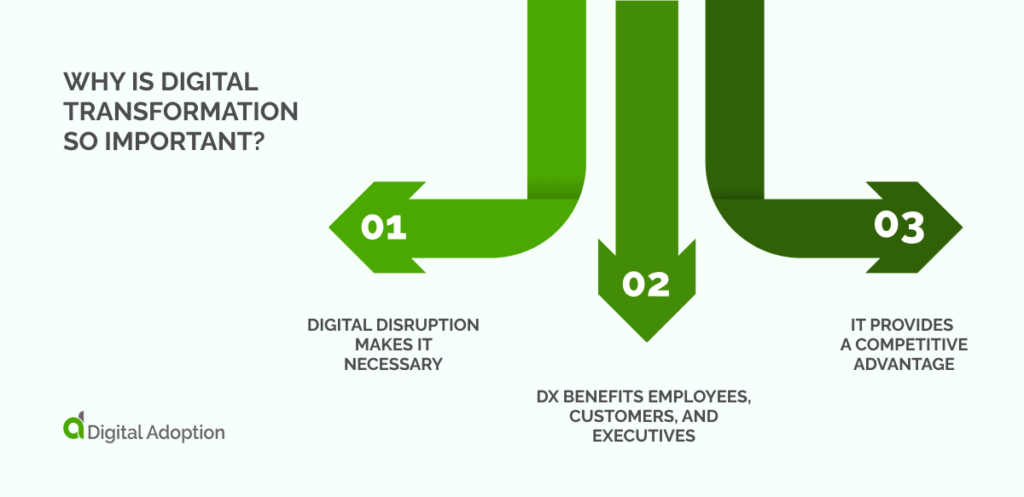
Digital tools have always offered companies the opportunity to improve daily processes. But today, more than ever, digitalization is vital for the growth of all companies.
1. Digital Disruption Makes it Necessary
Digital disruption is fueling transformation on a global scale.
Consider the COVID-19 pandemic and its impact on the way we all work. According to research conducted by Gartner, ‘almost 50% of employees will continue to work remotely post COVID-19’ After much of the global workforce moved to remote working, businesses realized the importance of digital assets.
The solution to remote work was digital technology, specifically video conferencing software. Thriving in the digital era means preparing for disruptions as new technology continues to change the way we work. This involves investing in digital solutions and creating a digital-first company.
2. DX Benefits Employees, Customers, and Executives
The right software improves the employee experience by making their work more rewarding and meaningful. It’s all about helping your employees adapt to digital transformation. You can onboard new employees much faster, and existing employees can master advanced features of new software. Digital transformation makes this possible.
Improving employee satisfaction leads to a better customer experience. Organizations need to meet customers’ expectations to survive in the digital era.
For example, when visiting a company website, customers want all their information in one place and automated support such as online self-service. Investing in web-based applications and training support staff helps create a seamless customer experience.
Business partners want to see that their digital transformation investment has paid off.
3. It Provides A Competitive Advantage
Organizations invest in digital technology to stay relevant in an evolving market. But technology alone isn’t enough to stay ahead of the competition. Leveraging technology investments means providing a better service for customers.
To achieve this, companies must support the adoption process from within. IT support for employees is crucial. Employees need support, whether learning a software’s basic functions or adapting to a new work process.
Increased automation provides a seamless customer experience, but don’t neglect to invest in proper support staff.
The Future Of Work
As the digital adoption revolution transforms the workplace, the employees who adapt quickly will thrive. Many experts predict that tomorrow’s workers will be lifelong learners, meaning they’ll constantly learn new working methods.
Digital adoption is not an option. It’s a necessity. Customers expect companies to offer the best service possible, which often involves utilizing technology. Customers are increasingly more tech-savvy. They look for companies with the best digital platforms that provide the quickest and easiest interactions.
Your organization needs to facilitate lifelong learning to survive in the digital era. Using tools such as digital adoption platforms will become standard features in every business.
It’s better to get started early rather than wait until it’s too late. Businesses that procrastinate find it challenging to implement new technology and suffer significant competition from early adopters.
We’ve covered the most helpful business adoption meaning for enterprises today and how organizations can use a DAP to improve theirs.
It’s reasonable to say that Digital Adoption Platforms are central to successful business adoption of digital. They provide the necessary mentorship and information to users during their onboarding and continuous use of the tool.
At the same time, they provide valuable information about how the adoption process is going, so you can better understand your business’s digital needs.

